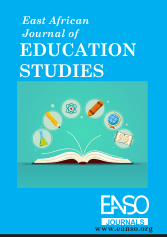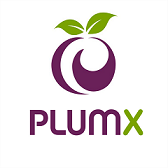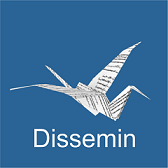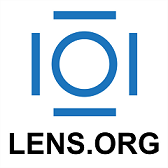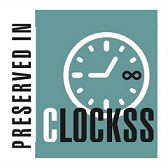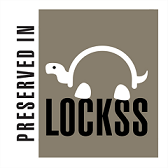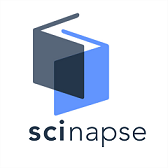Laboratory Materials Usage and Physics Practical Skills Acquisition among S.3 Students of Isingiro North County, Isingiro District
Abstract
This study examined the relationship between laboratory material usage and physics practical skills acquisition among Senior Three (S.3) students in Isingiro North County, Isingiro District, Uganda. The main objective was to evaluate the practical effect of laboratory material usage skills acquisition. The specific objective was to assess the extent of laboratory material usage among Senior Three (S.3) students in Isingiro North County, Isingiro District. A descriptive cross-sectional design was used, targeting 480 S.3 students, 12 physics teachers, and 6 laboratory attendants from six secondary schools. A sample of 162 participants was selected using stratified random and purposive sampling. Data were collected using questionnaires, interviews, and observational checklists, and analysed using SPSS for quantitative and thematic analysis for qualitative. Key findings revealed inconsistent laboratory material adequacy, with 40.3% of students reporting sufficient apparatus, but 86.8% lacked access to ICT tools. The study concluded that while basic laboratory resources were available, their inadequacy and the near-total absence of ICT tools hindered effective practical learning. Although students possessed basic skills, they struggled with advanced competencies like error analysis and independent experimentation. The study recommends increasing laboratory material quantities, investing in ICT infrastructure, and training teachers in resource utilisation. Policymakers should allocate targeted funding to rural schools to reduce resource gaps and improve physics practical learning outcomes.
Downloads
References
Achor, E. E., & Orji, D. (2010). Motivational effects of laboratory materials on secondary school students in Nigeria. Journal of Science Education, 4(2), 113–121.
Asian Development Bank. (2018). Comparative analysis of laboratory facilities and STEM education outcomes in Asia-Pacific. Manila: ADB.
Daily Monitor. (2021). Only 4% admitted for engineering lacked physics credit. Kampala, Uganda.
Eze, D. N., & Obike, C. O. (2015). Availability and use of laboratory resources in secondary schools in rural Nigeria. African Journal of Science Education, 5(1), 23–36.
Foulds, K., & Bekoe, S. O. (2018). Laboratory resources and physics performance in Ghanaian secondary schools. Ghana Journal of Education and Practice, 9(4), 92–104.
Harlen, W., & Holroyd, C. (2019). Science education in the 21st century: The role of ICT tools. International Journal of Science Teaching, 41(3), 211–227.
Isingiro District Education Office. (2021). Annual education statistical report. Isingiro District Local Government.
Kathari, C. R. (2004). Research methodology: Methods and techniques (2nd ed.). New Delhi: New Age International Publishers.
Krejcie, R. V., & Morgan, D. W. (1970). Determining sample size for research activities. Educational and Psychological Measurement, 30(3), 607–610.
Kumar, R. (2011). Research methodology: A step-by-step guide for beginners (3rd ed.). London: SAGE Publications.
Ministry of Education and Sports. (2018). National Education Sector Strategic Plan 2018/19–2022/23. Kampala: MoES.
Ministry of Education and Sports. (2020). Education sector performance report. Kampala: MoES.
Ministry of Education and Sports. (2022). Science education in Uganda: Gaps and strategies. Kampala: MoES.
Monk, D. (2010). Using interviews in educational research. Educational Research Methods, 2(1), 55–67.
Mugenda, O. M., & Mugenda, A. G. (2004). Research methods: Quantitative and qualitative approaches. Nairobi: ACTS Press.
National Learning Standards Council. (2020). Competency-based curriculum framework. Kampala: NLSC.
OECD. (2020). PISA 2018 Results: Effective policies for education outcomes. Paris: OECD Publishing.
Onen, D., & Oso, W. Y. (2008). A general guide to writing research proposal and report: A handbook for beginning researchers. Nairobi: Jomo Kenyatta Foundation.
Piaget, J. (1970). Science of education and the psychology of the child. New York: Viking Press.
Theodoridis, G., & Kraemer, M. (2004). Triangulation in survey research: Improving reliability. Journal of Social Science Research, 18(2), 142–158.
Uganda National Examinations Board. (2019). Annual performance report. Kampala: UNEB.
Uganda National Examinations Board. (2022). Physics subject performance summary. Kampala: UNEB.
UNESCO. (2021). Education for Sustainable Development: Laboratory facilities in sub-Saharan Africa. Paris: UNESCO.
Vygotsky, L. S. (1978). Mind in society: The development of higher psychological processes. Cambridge, MA: Harvard University Press.
West, A., & Ndubuisi, A. (2020). Teacher preparedness and laboratory resource use in Kenya. Journal of Educational Innovation, 7(1), 55–67.
Copyright (c) 2025 Isaac Opio, Richard Twebaze, Judith Arinaitwe

This work is licensed under a Creative Commons Attribution 4.0 International License.

